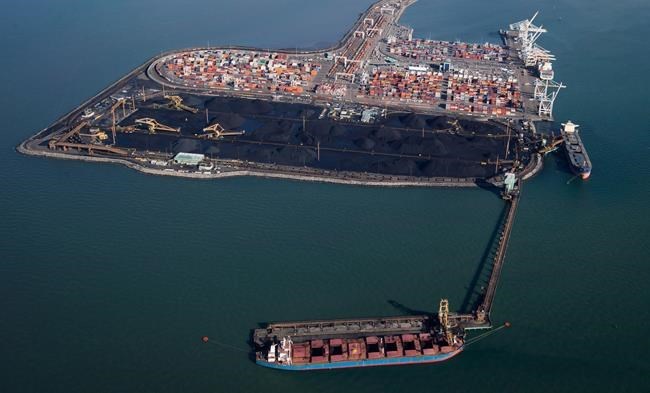VANCOUVER — A plan to build a new shipping container terminal the size of nearly 144 football fields at a major Metro Vancouver port has sparked a rival proposal along with concerns for endangered orcas and the salmon they depend on.
The three-berth, $3 billion terminal proposed by the Vancouver Fraser Port Authority would be built next to the existing Deltaport and Westshore terminals at Roberts Bank in Delta.
In 2020, a federally appointed independent review panel found the Roberts Bank Terminal 2 project would support competitiveness for Canadian markets and local communities could benefit from business and employment opportunities.
However, it also concluded the project would have "significant adverse"effects on southern resident killer whales, of which just over 70 remain in the wild. It would also affect the availability of the orcas' favoured prey, chinook salmon.
The port has since changed its original proposal to reduce harmful effects.
Draft conditions for the project, released by the Impact Assessment Agency of Canada, show the port would be required to consult with provincial and federal government agencies and Indigenous groups to develop mitigation measures.
The deadline is Tuesday for the public to comment on the project before the federal environment minister decides whether the effects would likely be significant and refers them to cabinet to determine whether they are justified in the public interest.
At the same time, a review panel has been tasked with examining an alternative proposal to increase capacity at the port by Global Container Terminals.
The Vancouver-based company operates the existing Deltaport terminal,for which the port authority is the landlord. Global is proposing to add a fourth berth for ships and expand a rail yard along the five-kilometre causeway that connects the port to land.
A description of the $1.6 billion-project, submitted to the B.C. Environmental Assessment Office last year, says it would have a smaller footprint than a new terminal and it would not extend the port any farther into the ocean.
The fourth berth would also be located in the southern resident killer whales' protected habitat and the company has proposed measures to mitigate its potential affect wildlife.
Ken Ashley, director of the Rivers Institute at the B.C. Institute of Technology, was among the scientists who wrote to Environment Minister Steven Guilbeaultlast month outlining the importance of the Fraser River estuary for at-risk species.
If the federal government doesn't reject the port's plan, Ashley said, it should postpone its decision to consider the proposal for a fourth berth.
Salmon use estuaries to acclimatize while migrating from the ocean to freshwater spawning areas, Ashley explained.
Chinook are especially dependent on estuaries. They spend more time in the mix of salt and freshwater than some other species as they feed and gather strength to head farther out in the ocean, he said.
Delta Mayor George Harvie also wrote to Prime Minister Justin Trudeau last month, saying city council had unanimously endorsed recommendations that Ottawa either reject the port's plan or postpone its decision until it's determined which of the two projects would have fewer adverse effects.
The Canadian Environmental Assessment Act does not allow for the suspension of an ongoing assessments at the request of the public, the Impact Assessment Agency said.
Duncan Wilson, the port authority's vice-president of environment and external affairs, said the new terminal has been planned for a decade, putting it significantly ahead of the fourth berth project in the assessment process.
Canada urgently needs to handle more shipping containers on the West Coast or it will start running out of capacity between 2025 and 2028, he said in an interview.
"Some of the supply chain congestion the country is experiencing right now is exactly what we're going to start to experience if Terminal 2 isn't delivered," he said.
"That basically means jobs and opportunity lost to the United States and an impact on our sovereignty in terms of our ability to trade with the Asia Pacific region."
Global Container Terminals said in a statement that Canada has "plenty" of terminal capacity to meet demand and forecasts show additional capacity beyond expansion that's already underway won't be needed until the 2030s.
The Port of Prince Rupert is also expanding, the company noted.
While Global Container Terminals said its fourth berth would have a footprint about a third of the size of Roberts Bank Terminal 2 without extending the port father into the ocean, Wilson said the plan for the terminal to stretch into deeper water follows advice from the federal Fisheries and Environment departments in the 2000s.
"They told us to stay away from the shallow intertidal habitat," he said.
"We've designed the terminal in a way that minimizes the impact on fish and fish habitat and we'll construct and operate the terminal in a way that minimizes any impact or eliminates in most cases impact on southern resident killer whales."
This report by The Canadian Press was first published March 13, 2022.
Brenna Owen, The Canadian Press




